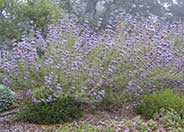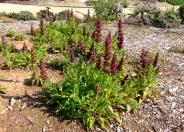
Common name:California Poppy, Golden Poppy
Botanical name:Eschscholzia californica
This small annual (sometimes acts as a perennial) plant will grow to less than 1' tall and has light, small blue/green leaves with gold and orange flowers that bloom in spring and summer.

Common name:Winifred Gillman Blue Sage
Botanical name:Salvia clevelandii 'Winifred Gillman'
The ' Winnifred Gilman' sage is a dense, compact sub-shrub that grows to 4-5 feet tall and wide, and has a round form. It has blue flowers in spikes above the foliage in the spring and summer. This sub-shrub is native to California and is drought tolerant. -Cornflower Farms

Common name:Howard McMinn Manzanita
Botanical name:Arctostaphylos densiflora 'Howard McMinn
This shrub is highly appreciated for its decorative characteristics, which include a dense show of small, pale pink, urn-shaped flowers. Above all, it is the mahogany-red to brown bark (which peels beautifully) that is the major attraction.
Its fruit resembles the tike apple, and the flowers contrast perfectly to the light green leaf (which can get rather tough). It blooms from late winter to spring. - Cornflower Farms

Common name:Moonshine Yarrow, Milfoil, Sneezewo
Botanical name:Achillea 'Moonshine'
Long, straight stems with pale yellow flowers are striking on the mats of green to grey-green leaves of this plant, which are flatter and less divided than those of the Achillea millefolium. This Yarrow propagates easily from rooted cuttings or divisions which should be performed in the early spring or fall. Following bloom, one should dead head the plant and divide the clumps when it appears crowded. Introduced by Alan Bloom in the 1950's.

Common name:Hummingbird Sage, Pitcher Sage
Botanical name:Salvia spathacea 'Las Pilitas'
The extravagant leaves of this small clumping sage emit a perfectly sweet fragrance, which attracts hummingbirds. In the spring, the reddish pink flowering spikes become a deep fuchsia. It is a great plant for dry shade. This variety grows lower than the parent plant and the flowers stay closer to the foliage.
Designer:
Photographer: Kathy Kramer
Practice grass-cycling by leaving short grass clippings on lawns after mowing, so that nutrients and organic matter are returned to the soil.
Drip and other smart irrigation delivers water directly to roots, allowing no excess water for weeds.